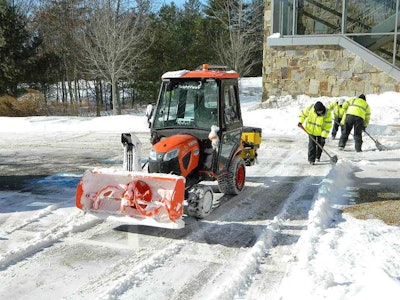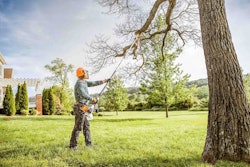 Photo: BrightView
Photo: BrightViewAs apocalyptic as last week’s bomb cyclone sounded, it did not stop the BrightView teams along the East Coast from completing their tasks.
The weather phenomenon isn’t particularly rare, but by meteorological standards, it is considered explosive. It occurs when a low-pressure system’s atmospheric pressure drops 24 millibars in 24 hours. Millibars are used to measure the strength of a storm system.
Drops in the atmospheric pressure allow the storm system to pick up more air and become stronger, resulting in hurricane-force winds. The entire East Coast was affected by cold temperatures, and record-breaking snowfall occurred in several locations including Tallahassee, Florida, Boston, Massachusetts and Charleston, South Carolina.
“We could clear a parking lot, turn around and it would be covered in snow again,” said Dave Harter, BrightView’s northeast regional snow manager.
Certain coastal areas in New England like Boston experienced icy flooding, but according to BrightView, this did not discourage the teams from heading out to clear roadways and pathways at client sites.
The winter storm also brought dangerously low temperatures and wind chills. The JFK Airport in New York City recorded a low of 9 degrees while in parts of eastern Pennsylvania temperatures slipped below zero.
“This is definitely the coldest event we’ve had in quite some time,” Harter said. “The extreme cold also wreaks havoc on machinery. Fuel in some diesel trucks will turn into jelly and prevent trucks from moving. We tried to plan for and take extra steps to make sure our machines were able to run and that we could do our best to prevent it from happening.”
Charlotte and New Bern, North Carolina, had temperatures hit 8 and 5 degrees respectively on Jan. 5 and 6, while Mount Washington in New Hampshire had temperatures of minus 36 degrees with the wind chill being minus 90, due to hurricane-force gusts clocking in at 92 mph.
The low temperature led to dry snow, allowing the winds to cause significant drifting and white out conditions.
“The drifting snow from the wind was terrible,” Harter said. “The estimates for Long Island and most of the northeast were significantly underestimated, so it initially caught a lot of neighborhoods off-guard.”
Parts of Virginia, such as Virginia Beach, were hit hard by the storm and BrightView teams from northern Virginia and Washington DC traveled to lend a helping hand.
“We had about 80 additional team members and 50 pieces of equipment to help us respond to our clients quickly and deal with what mother nature gave us,” said Chris Greene, vice president and general manager of BrightView’s Mid-Atlantic region.
Even Florida was affected by the extreme weather, with the cold temperatures sending iguanas into near-frozen states and freezing landscaping.
“The extreme cold weather we saw last week will inevitably result in cold-damaged plant material in most of Florida,” said Ian Rodriguez, BrightView director of technical services. “Damage is typically most severe in open areas of a landscape away from buildings and tree canopies. In all types of plants, cold damage goes hand-in-hand with leaf desiccation due to winds and cell damage.”











